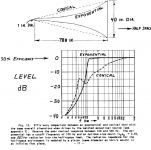Ok, I am still working on learning the basics of waveguide design from the many excellent posts here and around the web. Please bear with me.
Most horn/waveguide product descriptions include some variant of this phrase, provides good loading down to X Hz. I don't understand what this means. Should the HF driver not be used under that frequency? Should it be crossed at that frequency? Is it just a directivity change, and how does that impact the overall output shape?
To put this in some context, I'm intrigued by the new Celestion Axi2050 - the big heavy axiperiodic down to 300 Hz monster. The largest waveguides on PE provide loading down to 400-500 Hz. What happens if I put the Axi at the back of one of these waveguides? I mean just on its own without a speaker system around it, what happens? And how does that inform crossover design when it does go into a system? The spec sheet provides a response curve with a 30" horn so maybe I'm way off the path here and it's just not supposed to be used this way at all.
(P.S. To clarify, I am not planning a build. I'm playing with on-paper concepts to try and better understand how different systems might behave.)
Most horn/waveguide product descriptions include some variant of this phrase, provides good loading down to X Hz. I don't understand what this means. Should the HF driver not be used under that frequency? Should it be crossed at that frequency? Is it just a directivity change, and how does that impact the overall output shape?
To put this in some context, I'm intrigued by the new Celestion Axi2050 - the big heavy axiperiodic down to 300 Hz monster. The largest waveguides on PE provide loading down to 400-500 Hz. What happens if I put the Axi at the back of one of these waveguides? I mean just on its own without a speaker system around it, what happens? And how does that inform crossover design when it does go into a system? The spec sheet provides a response curve with a 30" horn so maybe I'm way off the path here and it's just not supposed to be used this way at all.
(P.S. To clarify, I am not planning a build. I'm playing with on-paper concepts to try and better understand how different systems might behave.)
Last edited:
Bjørn Kolbrek has written some great articles about horns.1)Most horn/waveguide product descriptions include some variant of this phrase, provides good loading down to X Hz. I don't understand what this means. Should the HF driver not be used under that frequency?
2)Should it be crossed at that frequency?
3)Is it just a directivity change, and how does that impact the overall output shape?
4) The largest waveguides on PE provide loading down to 400-500 Hz. What happens if I put the Axi at the back of one of these waveguides? I mean just on its own without a speaker system around it, what happens? And how does that inform crossover design when it does go into a system? The spec sheet provides a response curve with a 30" horn so maybe I'm way off the path here and it's just not supposed to be used this way at all.
(P.S. To clarify, I am not planning a build. I'm playing with on-paper concepts to try and better understand how different systems might behave.)
https://kolbrek.hornspeakersystems....brek_-_Horn_Theory_An_Introduction_Part_1.pdf
1) The horn driver is a high impedance source, coupled through the horn to a low impedance air "load". The driver/horn output will drop rapidly below Fc, the frequency the horn starts to "unload".
2) Crossover should generally be above Fc, the horn's -3dB cutoff frequency. The steeper the crossover, the closer to Fc the HF driver can be used without the diaphragm excursion being enough to contact the phase plug, which sounds terrible, and may quickly ruin the diaphragm even with relatively little power used.
3) Directivity is independent of loading, a simple pipe provides good LF loading, but lousy polar response.
4)Unfortunately, without measuring the specific combination, hard to make well informed decisions.
Plane wave tube response of drivers will give an idea of the low frequency response possibilities, the Axi2050 could probably be used down to 120 Hz on an exponential horn like in Don Keele's picture below.
Note the difference in Fc between the conical and exponential expansions.
Art
